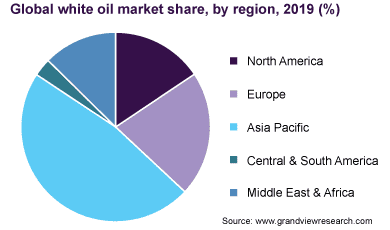White Oils – Global Market and Future Trends
Properties
- Colourless, odourless & tasteless
- Extremely pure and stable
- Non-toxic, chemically & biologically inert
- Superior thermal & UV stability
- Hydrophobic / Moisture resistant
- Excellent lubricity and insulation properties
White oil is an important component used in the chemical, pharmaceutical, cosmetics and food processing industries. White oils are generally recognized as a class of highly refined and versatile mineral oils and are generally produced from paraffinic or naphthenic base-stocks from the refineries. White oils are odourless, tasteless, chemically inert, colourless and biologically stable in nature. These oils have excellent storage life and they also do not change colour over time. White oils are available in five different grades which are chemically distinct from each other. Most of them contain Vitamin E, which protects it from natural oxidation and steadies it during storage.
A Brief History
 The term ‘White Oil’ is a little ambiguous in the sense that they are not white at all, but crystal clear. The term for these high purity oils was originally used to differentiate them from less refined darker oils. White oil is similar to petrolatum, which is better known by its brand name, Vaseline, a jellied mixture of solid and liquid hydrocarbons first manufactured out of Pennsylvania crude oil in 1872. Attempting to make their own Vaseline, but with a chemically different kind of oil, Russian engineers instead produced the odourless, colourless, and tasteless white oil. The technology for refining white mineral oil was first established in 1887 in Russia.
The term ‘White Oil’ is a little ambiguous in the sense that they are not white at all, but crystal clear. The term for these high purity oils was originally used to differentiate them from less refined darker oils. White oil is similar to petrolatum, which is better known by its brand name, Vaseline, a jellied mixture of solid and liquid hydrocarbons first manufactured out of Pennsylvania crude oil in 1872. Attempting to make their own Vaseline, but with a chemically different kind of oil, Russian engineers instead produced the odourless, colourless, and tasteless white oil. The technology for refining white mineral oil was first established in 1887 in Russia.
Over the next 25 years the process was improved so that high-quality white oils could be used for medicinal (or pharmaceutical) and special industrial applications. White oils were exported all over the world, especially to North America, until in 1917 when the US entered the First World War, a number of major US oil companies had to start producing white oils.
Applications and Global Market of White Oils

In terms of volume, personal care applications led the market with a share of 28.7% in 2019 as per the reports in grandviewresearch.com. This is attributed to widespread product application in the formulation of baby oils, hair and skincare products, such as serums, creams & lotions and makeup products. White oil has the ability to protect skin from the harmful external environment. It is also broadly utilized in the formulation of anti-ageing products, which have high demand, especially in various East & North Asian countries. The Asia Pacific led the market in 2019 and accounted for over 51% of the global revenue share.

White oil is widely used in the manufacturing of speciality adhesives and elastomers due to its water and moisture-resistant properties, which are also estimated to fuel the expansion of the global white oil market. White oils are certified safe for their application in food and dietary products attributed by the halal and the kosher certification to white oil, which has resulted in its rising demand around the globe. White oils are biologically stable product and do not support pathogenic bacterial growth, thus, it is widely used in medicinal & food grades products.
“Rising demand in medical & cosmetics applications worldwide is projected to be a key driving factor for the market growth”
The key sectors driving this growth are as follows:
Personal Care – baby oil, cosmetics, hair care, emollients, lotions and moisturizers
Pharmaceutical – ointments, creams, laxatives and the preparation of gelatinous capsules
Adhesives – as a plasticizer for food contact materials
Agriculture – dedusting agent for seeds, low toxicity insecticide for plants and milking lubricants
Food – a key ingredient in food-grade lubricants and release agents for cutting tools, chopping boards and hard surfaces to stop food adhering
Textile – used for spinning, weaving and meshing materials. Also used for sewing machine lubrication
Polymers – extender oil for TPE formulation and plasticizer for food contact containers
Others – candles, trimmer lubricating oil, etc.
Future Trends
The market globally for white oil is expected to grow at a Compound Annual Growth Rate (CAGR) of approximately 1.5 % during the period of 2019 – 2024 according to a market research site ‘Mordor Intelligence’. Asia Pacific (APAC) region is both the largest and fastest-growing market for white oil. The personal care and pharmaceutical industries in the Asia Pacific (APAC) region are expanding rapidly. APAC is anticipated to dominate the market for white oils with a healthy CAGR during the said period. In India, the largest application of white oils is in the hair oil. The overall cosmetics and pharmaceutical industries account for around three-fourth of the white oil consumption in the country.
Expansion of the white oil market in North America is expected to be noteworthy during the forecast period due to significant demand from the food, cosmetics, and chemical industries. The white oil market in Europe is also projected to expand consistently. Economic and industrial expansion in the Middle East & Africa coupled with the rising demand for polymers and speciality chemicals in the region are assessed to boost the white oil market. The white oil market in Latin America is also likely to expand at a slow pace.
Manufacturers of white oils around the globe are putting their best efforts to fortify their market position by acquisitions and technology licensing, adding a portfolio of value-added products, and developing an enhanced and vigorous distribution network around the globe.
